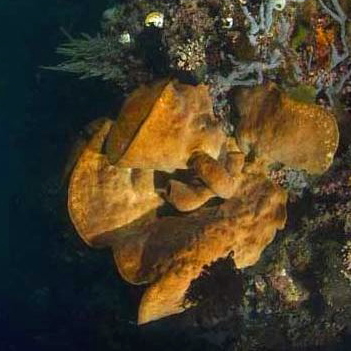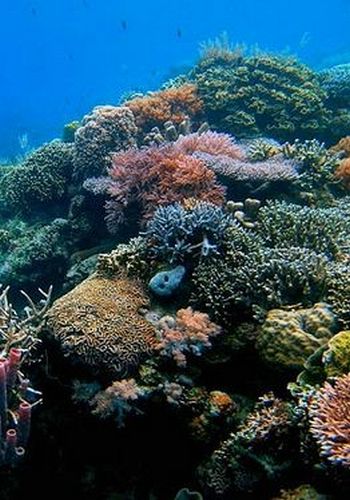Bioprospecting is threatening Bunaken National Park
Walter Balansa
Bunaken coral reefs are home to great biodiversityWalter Balansa |
Established in 1991 because of its magnificent biodiversity, Bunaken National Park is located in North Sulawesi province, only 35 minutes by boat from the provincial capital Manado. Covering an area of 890.65 square kilometres, it hosts many rare and endangered species, including the coelacanth (once believed to be extinct), dolphins and turtles. It is also a part of the migratory route for many economically important fish. Its natural beauty and rich marine resources mean that the park has a high economic value for both the local tourism and fisheries industries, with20,000 residents depending on the park for their livelihood.
Human activities such as illegal fishing and waste disposal problems have become an increasing threat over the last decade. Many international organisations have tried to find solutions to these problems and as a result, local governments and communities have become more aware of the value of natural resources and the importance of coastal resource management. However, one major threat remains unrecognised: the search for useful compounds from marine plants and animals for commercial purposes, or marine bioprospecting. In the last two decades, bioprospecting has led to the degradation of Bunaken, raising ethical, environmental and legal alarms.
In defiance of international law
The practice of bioprospecting emerged in response to the increasing resistance that many diseases have to drugs currently on the market – a situation that demands a constant supply of new medicines. Two patents and hundreds of scientific publications resulting from bioprospecting in Bunaken National Park strongly underline the important contribution of the park to scientific and drug discoveries.
Two research groups based in Manoa, Hawaii initiated marine bioprospecting in Bunaken in the early 90s. In just a few years, they discovered many new and useful compounds, mainly from sponges and tunicates (both marine animals). They were also granted a patent (US Patent No. 5,514,705) for an antitumor treatment. At this stage, no data in the public domain indicates any economic benefit from this particular patent. Discoverers normally have to secure their investment by patenting their discovery first. Then they use the patent to look for potential partners, normally big pharmaceutical companies, to develop their discovery. Even if they find a potential partner, twelve to fifteen years and approximately a million dollars are needed to develop a drug or drugs, which may or may not make it to market.
Despite the poor odds of discovering a viable drug, the grip of bioprospecting on Bunaken’s marine biodiversity will remain tight for many years to come. The success of the Hawaii teams attracted many more scientists from countries including Japan, the USA, Spain, Italy, Canada and Portugal to Bunaken to join in the hunt. Their efforts have produced hundreds of publications in many prestigious international journals and even another patent (US Patent No. 6,900,195) for an antimalarial treatment. The fact that no one from Indonesia is cited in either of these patents is damning. It constitutes biopiracy, or unauthorised appropriation of biodiversity and local knowledge.
Foreign scientists own all the rights to the results of their bioprospecting in Bunaken
The United Nation Convention on Biological Diversity (CBD) stipulates that every country has sovereign rights over its biodiversity. International law obliges countries involved in utilization of biodiversities to practice sustainable development and apply fair benefit sharing, in the form of technological transfer, upfront payment and/or royalties. The United Nation Convention on the Law of the Sea (UNCLOS) also sets up certain obligations for coastal communities and foreign researchers, including the provision of information on research activities, acquiring permission, providing access data and accepting coastal state participation.
Yet when collecting specimens in Bunaken, overseas scientists tend to collaborate with local diving clubs rather than with local scientists or coastal communities. This benefits both overseas scientists and the local people who work for the diving clubs. After all, divers know better than anyone the marine biodiversity of the national park. However, it also enables overseas scientists to take advantage of the local knowledge of biodiversity while ignoring the rights of local communities and not fully meeting their obligations under UNCLOS. Foreign scientists own all the rights to the results of their bioprospecting in Bunaken. Indonesian scientists or the authorities in Jakarta, who gave permission for specimen collection, are credited as co-authors in many international publications but were not involved in the specimen collection, much less in laboratory work conducted overseas. At a glance, this appears to fulfil the UNCLOS requirements. In reality, however, it reflects nothing more than the actions of a very small group of people, called biotrade brokers, who make their fortunes by allowing access to genetic resources.
 |
Sponges are a favourite target of bioprospectorsWalter Balansa |
The United Nation Convention on Biological Diversity also recognises the practice of sustainable use of natural resources by stipulating that parties involved in using biodiversity have to practice sustainable development to counteract the serious threat from overzealous explorations in the environment. Ideally bioprospecting activities should collect only 1 kilogram or less of any individual species to ensure sustainable marine development. In Bunaken there are recorded cases of foreign scientists collecting up to 30 kilograms. In the case of US Patent No. 6,900,195 60 kilograms of a sponge was collected in order to obtain the four compounds covered in the patent. Producing compounds from marine animals is the most problematic issue in bioprospecting. For example, scientists obtain only 1 gram of trabectedin (an anticancer drug) from 1 ton of sea squirts. As with any drug candidate, trabectedin needs to complete four clinical trials. Each trial requires 5 milligrams of this compound. This means that twenty tons of sea squirts would be needed to complete all the trials. Fortunately, in this case, this compound could be replicated in the laboratory; this is not always the case.
By sharing benefits with biotrade brokers and ignoring local scientists and coastal communities, foreign scientists turn biodiversity into just another commodity to be unequally traded between the poor and the rich. To make matters worse, rich countries have a record of not paying their debts. A United Nations Development Program report revealed that developed countries owe developing countries over US$300 (A$324) million in unpaid royalties for crop seeds and US$5 billion in unpaid royalties for medicinal plants. Given the ingrained problems in the current use of Bunaken’s marine biodiversity, it is simply wrong to assume that the people of North Sulawesi, and Bunaken National Park in particular, will gain more from this system than they lose.
Finding a solution
One of the barriers to finding an effective solution to the problem of biopiracy is that the central government doesn’t always have the interests of the local community at heart. Indonesia’s constitution stipulates that the state owns all resources to be used for the welfare of all people, but this may be interpreted differently at the local and national levels. Those in Jakarta use it to legitimise the exploitation of local biodiversities, while those in local areas believe they have the right to biodiversities in specific areas in accordance with regional autonomy. For example, when specimen collection took place on Bunaken’s coral reefs, it was in contravention to Law No. 32/2004, which puts these areas under the control of district or municipal authorities. Excessive specimen collection in a tourism-designated area also infringes Law No. 9/1999 along with other laws and regulations related to the environment and biodiversity. At the same time, an inefficient mechanism in issuing permission from local universities is a major reason why international scientists avoid collaboration with local scientists. It is also true that few people in Bunaken’s coastal communities have the skills to help foreign scientists in specimen collection.
Local government and politicians need to work together with the central government to solve any ambiguities related to the application of Law No. 32/2004 in North Sulawesi. They have to ensure that local regulations and laws related to biodiversity and environment are in place that meet the requirements of the national law. More importantly, local governments have to enforce these laws and regulations. In addition, local scientists need to implement reforms in their own institutions, as well as collaborating more with credible overseas research institutions and even creating a specific sharing mechanism for the utilisation of Bunaken’s biodiversity. Coastal communities in the park area should also be involved – and with appropriate training, would be able to participate in the development of a sustainable regime. These communities need to know what they have and how to protect what they have. After all, they are the only ones who have to live with the consequences of unchecked bioprospecting and the environmental devastation it could bring.
Walter Balansa (w.balansa@imb.uq.edu.au) is a PhD student at the University of Queensland, Australia.
This article is part of the Indonesia's Environmental Challenges mini-series.
